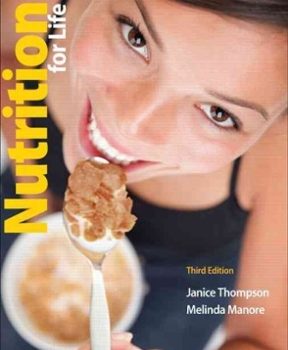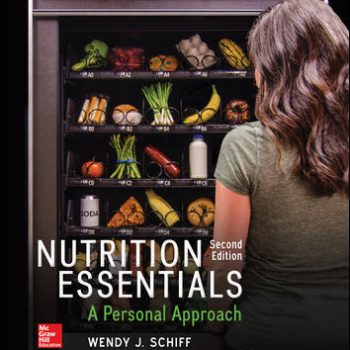Test Bank Nutrition Essentials A Personal Approach 2nd Edition By Wendy Schiff
Unit 03
|
1. |
A nutrient requirement is A. the recommended daily intake of a nutrient. B. the smallest amount of a nutrient that maintains a defined level of nutritional health. C. an amount of a nutrient that ensures optimal nutritional status. D. an amount of a nutrient that includes a “margin of safety.” |
|
2. |
Kevin was a participant in a clinical study to determine how much niacin cures pellagra, the niacin deficiency disease. During the study, he consumed only a formula diet that was deficient in niacin. After developing pellagra, he was given 2 mg of niacin a day for 2 weeks, but he still suffered from the disease, so the scientists added 2 mg of the vitamin to Kevin’s formula. By the beginning of the 5th week of the study, the researchers noticed that Kevin’s signs and symptoms were greatly improved. At the end of the 5th week, he was feeling fine. The researchers concluded that A. Kevin’s niacin requirement was about 4 mg a day. B. Kevin’s daily value for niacin was 4 mg a day. C. the AI for niacin should be 4 mg plus 60 mg as a margin of safety. D. the RDA for niacin should be 4 mg. |
|
3. |
Ramon was a participant in a clinical study to determine how much vitamin D is required by healthy humans. During the study, Ramon consumed only a formula diet that was nutritionally complete, except it did not contain vitamin D. Within a few weeks, he developed signs and symptoms of vitamin D deficiency. At that point, researchers gave 5 mcg vitamin D to Ramon each day for a week, but his signs and symptoms of the deficiency remained. The next week, the scientists added 5 mcg vitamin D to his diet, so that his formula contained 10 mcg of the vitamin. By the end of that week, Ramon reported feeling much better. Based on this information, the researchers concluded that Ramon’s A. RDA for vitamin D was 5 mcg, plus a margin of safety amount of 5 mcg. B. AMDR for vitamin D was between 5 and 10 mcg. C. daily required allowance for vitamin D was about 10 mcg. D. requirement for vitamin D was 10 mcg. |
|
4. |
Kayla was a participant in a clinical study to determine how much vitamin C cures scurvy, the vitamin’s deficiency disease. During the study, Kayla consumed only a formula diet that was nutritionally complete, except it didn’t contain vitamin C. Within a few weeks, Kayla developed scurvy. At that point, researchers gave 2 mg vitamin C to Kayla each day for a week, but her signs and symptoms of scurvy remained. In the weeks that followed, the scientists continued to increase Kayla’s intake of the vitamin by 2 mg/week. After a week of taking 10 mg of vitamin C/day, Kayla reported feeling much better. Based on this information, the researchers concluded that Kayla’s A. requirement for vitamin C was 10 mg. B. EER for vitamin C was about 10 mg. C. RDA for vitamin C was 10 mg, plus 15 mg as a margin of safety. D. AI for vitamin C was 100 mg, which was 10 times the amount that cured her case of scurvy. |
|
5. |
A group of 50 adult male humans were in a clinical study to determine how much niacin is toxic. During the first two weeks of the study, members of the group consumed only a formula diet that was nutritionally complete, except it contained 24 mg niacin, which is 1.5 times the RDA for niacin (males). At that point in the study, all members reported feeling fine, and they could function normally. During the next week, they were given a formula that contained 48 mg niacin. Within a few days of consuming this formula, 90% of the participants reported feeling ill, and they complained of having upset stomachs and reddened facial skin. At that point, researchers gave the subjects a formula that contain 16 mg niacin. After a week of consuming the new formula, all participants reported feeling well again. Based on this information, the researchers concluded that the A. AMDR for niacin is between 16 and 24 mg/day. B. EER for niacin was 16 mg/day. C. UL for niacin was between 24 and 48 mg/day. D. human requirement for niacin is 16 mg/day. |
|
6. |
Josh was a participant in a clinical study to determine how much thiamin cures beriberi, the vitamin’s deficiency disease. During the study, Josh consumed only a formula diet that was nutritionally complete, except it didn’t contain thiamin. Within a few weeks, Josh developed beriberi. At that point, researchers gave 0.2 mg of thiamin to Josh each day for a week, but his signs and symptoms of beriberi remained. In the weeks that followed, the scientists continued to increase Josh’s intake of the vitamin by 0.2 mg/week. After a week of taking 0.6 mg of thiamin/day, Josh reported feeling much better. Based on this information, the researchers concluded that Josh’s A. AMDR for thiamin was between 0.2 and 0.6 mg/day. B. RDA for thiamin was 0.6 mg/day. C. UL for thiamin was 0.2 mg/day. D. requirement for thiamin was 0.6 mg/day. |
|
7. |
Recently, Miriah participated in a study that was designed to determine how much iron is necessary to prevent iron deficiency. Within a few weeks of consuming an iron-free diet, Miriah’s red blood cells began to show signs that they lacked iron, and she began to complain about feeling tired. At that point, the researcher added some iron to Miriah’s food, so her daily intake of the mineral was 1 mg. After 1 week, the researchers checked the iron content of Miriah’s blood, and although it was higher than the earlier value, she still complained about feeling tired. In the weeks that followed, the scientists continued to increase Miriah’s iron intake by 1 mg/week and check her for signs and symptoms of iron deficiency. After a week of taking 6 mg of iron/day, she reported feeling like “her old self” and having plenty of energy. Based on this information, the researchers concluded that Miriah’s A. UL for iron was 6 mg, plus 3 mg as a margin of safety. B. AMDR for iron was 6 mg/day. C. body required 6 mg iron/day. D. RDA for iron was 6 mg. |
|
8. |
The amount of vitamin C that meets about 98% of the population’s need for the nutrient is the _____ for the vitamin. A. EAR B. UL C. %DV D. RDA |
|
9. |
A team of scientists determines that 50% of healthy women who are between 19 and 30 years of age need 40 mg of a vitamin to prevent developing the vitamin’s deficiency disorder. Based on this information, the A. women can meet their AMDR for the vitamin by consuming at least 40 mg/day. B. UL for the vitamin will be based on the EER value. C. scientists can determine the RDA for the vitamin. D. women will develop the vitamin’s toxicity disorder when they consume between 40 and 50 mg of the vitamin on a daily basis for about 10 weeks. |
|
10. |
Which of the following statements is true? A. Registered dietitians use MyPlate as the standard for assessing a population’s nutrient adequacy. B. If you do not consume 100% of the RDA for vitamin C each day, you have a high risk of developing the vitamin’s deficiency disease. C. The RDA for vitamin E meets the needs of nearly all healthy persons. D. Registered dietitians use Daily Values to determine the nutritional adequacy of Americans’ diets. |









Reviews
There are no reviews yet.